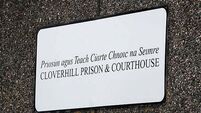Question of taste: Actor Stephen Dillane on his cultural reference points through the decades

Currently in Cork for a Beckett play, actor Stephen Dillane tells about some of his cultural reference points through the decades.
Stephen Dillane stars in How It Is (Part 2), an adaptation of Samuel Beckett’s novel currently running at the Everyman in Cork. Best known for playing Stannis Baratheon in Game of Thrones, Dillane has also starred in TV series The Tunnel, and numerous other films and stage productions.
Born in London in 1957, the 62-year-old is married to Naomi Wirthner, and the couple have two children, Seamus and Frank (who plays Tom Riddle in Harry Potter and the Half-Blood Prince).
It’s the second time the London-born actor has collaborated with the Gare St Lazare company, run by Cork couple Conor Lovett and Judy Hegarty-Lovett. Last year, he also joined the company for part one of the adaptation.
TV
“There seems to be so much on TV that I can be a bit overwhelmed, and I have an inbuilt resistor. Sometimes I’ll watch one or two episodes of a series, but even if I think it’s good, I might leave it behind.
A show I really enjoyed recently was The Virtues from Shane Meadows. I thought Helen Behan was extraordinary.
Fleabag was also great, and I used to really enjoy Grand Designs.
I didn’t watch all of the final series of Game of Thrones, but I did see the last few episodes. I found it very disappointing the way it drifted away at the end. I don’t know if it’s because they had moved away from the books and didn’t have that underpinning it.
As a child, it was all the usual stuff — Batman, Thunderbirds, etc, and I used to love the Western series Temple Houston. I particularly remember the opening sequence which featured a bullet hitting the spur on a boot, and the spur spinning.
Later I got into Blue Peter and started getting into football around 1967. Back then Match of the Day used to just focus on one game. I also started going along regularly to Stamford Bridge, and also Highbury and to Selhurst Park, as a lot of my school friends were Crystal Palace fans.
Theatre
My mother brought us to a lot of stuff in London. I saw Peter Brook’s A Midsummer Night’s Dream, which was a seminal production. I also got to see Laurence Olivier in Eugene O’Neill’s Long Day’s Journey Into Night.
Back then, it wouldn’t have occurred to me to be an actor.
That was something I fell into. I worked as a journalist after college but didn’t like it. Then I remembered how much I enjoyed studying English literature and I decided to go to theatre school.
Books
As a child, it was a lot of the usual middle-class stuff, being read Winnie-the-Pooh and so forth. When I began reading for myself, I remember really enjoying the Narnia books.
Also Henry Treece’s historical novels, about Vikings and the like. They’re usually about boys going off on adventures.
Later, everyone from John Dos Passos’ U.S.A.trilogy to Kafka’s Letter to His Father, Patrick White, Milan Kundera.
More recently, I read Moby Dick for the first time, on the back of working with Conor Lovett, who did a one-man show from the book. I loved it.
I also really like the My Struggle books by Karl Ove Knausgård, and would recommend them to anyone.
Music
My mother bought me my first record, which was ‘Can’t Buy Me Love’ by The Beatles.
She also brought us to A Hard Day’s Night in the cinema. When we’d go on holidays, we’d go on these very long drives, so we’d all be singing as we drove along.
As a teenager when I began to develop my own tastes, I was big into bands like Deep Purple and Black Sabbath. I used to go a lot of gigs when I was at the University of Exeter in the mid-1970s.
The standout was Bob Marley and the Wailers in 1976. It was a fantastic night in so many ways... quite life changing. I’m still a fan. I also listen to a lot of Bob Dylan, including some of the later stuff, albums such as Time Out of Mind [1997] and Tempest [2012].
And Van Morrison is still my go-to man. These days I listen to a lot of classical music on the radio from BBC Radio 3.
Art
We were brought a lot of galleries in London when we were young but we used to think it was boring.
Now I go to see a lot of exhibitions — it’s one of the advantages of living near a big city. I’m quite unprejudiced and will go to see anything.
I really liked the exhibition of Bauhaus artist Anni Albers at the Tate Modern.
Also the recent Franz West exhibition, anartist I never knew of before. I didn’t even like the picture they were using to advertise the exhibition, but when I went in I was thrilled with whatI saw.
Film
The first film I was ever allowed go to on my own was Grand Prix [1966], the car-racing film with Yves Montand.
Standouts from my younger days include films such as Bad Timing, The Long Goodbye, Jaws, and The French Connection. Richard Pryor Live in Concert was probably the biggest single influence on me.
I still go to the cinema quite regularly, and we have a new cinema near where we live. I like Lars von Trier, and unlike a lot of people, I don’t find him shocking — I find him quite realistic.
I also like film-makers like Quentin Tarantino and MichaelHaneke.”










